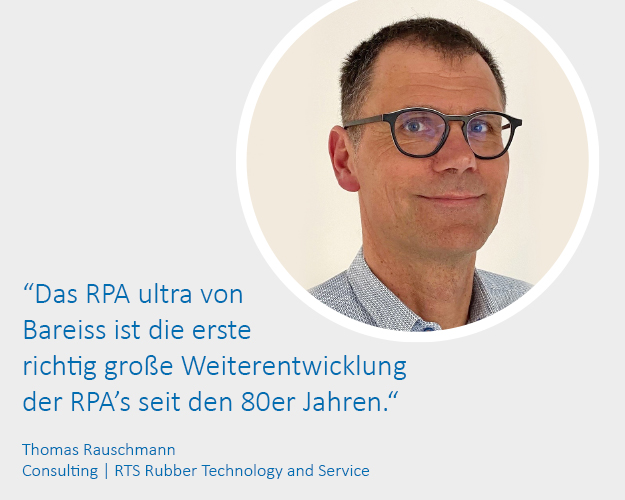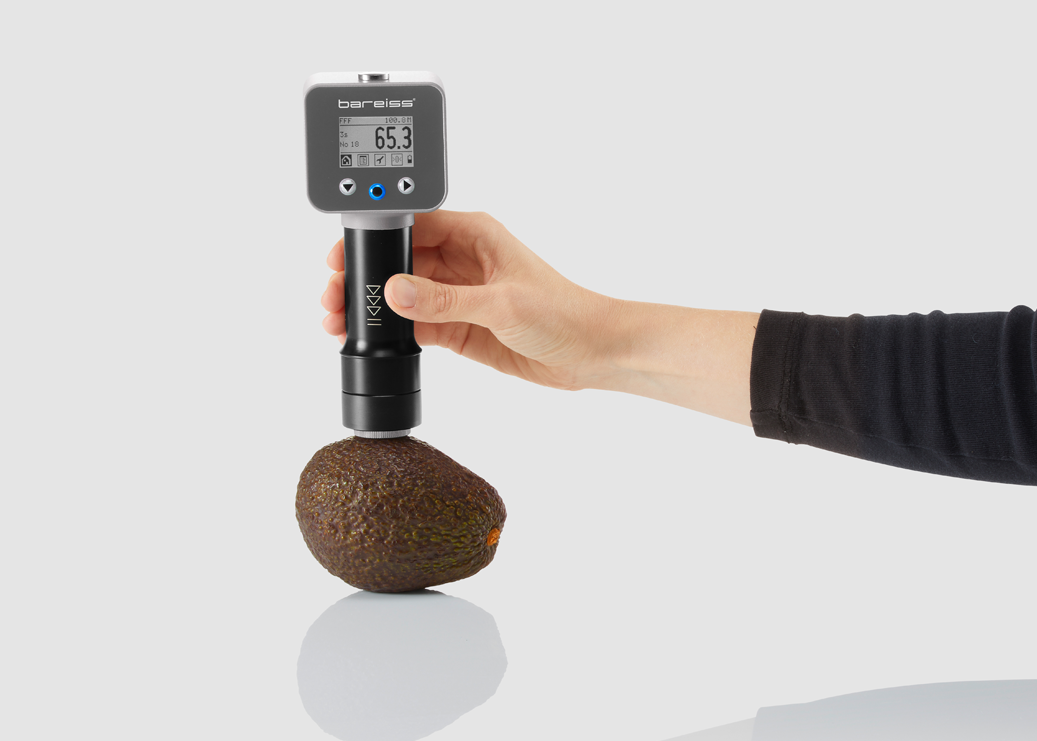Select your language
- RPA ultra – The future of material testing starts now.
- Produkte

RPA ultra - The future of materials testing at starts now. Discover our world novelty.
State of the Art
In the version of the RPA used by Monsanto to date, only oscillatory tests with variable frequency and strain can be performed – and thus usually used to determine the complex shear modulus and dynamic viscosity of a material. The classical approach of calculating both the storage modulus and the loss modulus with a simple trigonometric equation only applies to linear viscoelastic behavior.The Problem
Filled rubber compounds, however, show a strongly non-linear rheological behavior (Payne effect) and the measurement signal of unfilled raw rubber becomes nonlinear at higher deformations (LAOS). The issue of compound processability also cannot be quantified to date. As a solution-oriented company, Bareiss has addressed this problem as part of a cooperative project funded by the ZiM and has developed an RPA with extended testing capabilities. This new type of advanced RPA testing allows access to valuable information contained in higher harmonics, steady-state shear viscosity or non-elliptic Lissajous figures.“The RPA ultra shiftsthe quality of testing to an unrivaled level.”
The Solution
The rotational lower die allows the transient viscosity of materials to be determined for the first time in areas that are highly relevant to production. Compared to dynamic viscosity, transient viscosity reflects the realistic processing of rubber compounds. The RPA ultra from Bareiss can certainly perform all test methods of a generic RPA, including isothermal and anisothermal tests, stress relaxation, frequency sweep and amplitude sweep.
Not only is it capable of performing oscillatory testing over a wider range of frequencies (10-3 Hz to 100 Hz) and strain range (unlimited strain LAOS), but also offers the possibility to perform a continuous shear rate in full rotation from 10-3 s-1 to 500 s-1, while standard RPA‘s can only measure up to a maximum of 30 s-1.“This groundbreaking technology is different from any RPA on the market.”
With this type of test, the instrument has successfully measured constant shear viscosity with high repeatability without having to make the corrections required by capillary rheometers, for example.
The application
This instrument thus expands the range of applications to better describe, among other things, current topics in rubber technology such as wall slip behavior, polymer branching and sustainable fillers (rCB). The number of data points recorded per cycle has increased significantly, which in turn improves the signal-to-noise ratio when performing Fourier Transform Rheology.The ranges in which the device operates at shear rates of 500 s-1 are typical of the extrusion range. Initial studies have already shown that such a measurement method can be used to make an estimate of the processability of a compound. This means that in the event of substitution or fluctuations in raw material quality, the user can recognize at a very early stage whether this compound can be processed well or whether further processing aids need to be added – this also offers crucial time saving and financial advantages in the new development of rubber compounds.

RPA ultra – The future of material testing starts now.
State of the Art
In the version of the RPA used by Monsanto to date, only oscillatory tests with variable frequency and strain can be performed – and thus usually used to determine the complex shear modulus and dynamic viscosity of a material. The classical approach of calculating both the storage modulus and the loss modulus with a simple trigonometric equation only applies to linear viscoelastic behavior.
The Problem
Filled rubber compounds, however, show a strongly non-linear rheological behavior (Payne effect) and the measurement signal of unfilled raw rubber becomes nonlinear at higher deformations (LAOS). The issue of compound processability also cannot be quantified to date. As a solution-oriented company, Bareiss has addressed this problem as part of a cooperative project funded by the ZiM and has developed an RPA with extended testing capabilities. This new type of advanced RPA testing allows access to valuable information contained in higher harmonics, steady-state shear viscosity or non-elliptic Lissajous figures.
“The RPA ultra shiftsthe quality of testing to an unrivaled level.”
The Solution
The rotational lower die allows the transient viscosity of materials to be determined for the first time in areas that are highly relevant to production. Compared to dynamic viscosity, transient viscosity reflects the realistic processing of rubber compounds. The RPA ultra from Bareiss can certainly perform all test methods of a generic RPA, including isothermal and anisothermal tests, stress relaxation, frequency sweep and amplitude sweep.
Not only is it capable of performing oscillatory testing over a wider range of frequencies (10-3 Hz to 100 Hz) and strain range (unlimited strain LAOS), but also offers the possibility to perform a continuous shear rate in full rotation from 10-3 s-1 to 500 s-1, while standard RPA‘s can only measure up to a maximum of 30 s-1.
“This groundbreaking technology is different from any RPA on the market.”
With this type of test, the instrument has successfully measured constant shear viscosity with high repeatability without having to make the corrections required by capillary rheometers, for example.
The application
This instrument thus expands the range of applications to better describe, among other things, current topics in rubber technology such as wall slip behavior, polymer branching and sustainable fillers (rCB). The number of data points recorded per cycle has increased significantly, which in turn improves the signal-to-noise ratio when performing Fourier Transform Rheology.
The ranges in which the device operates at shear rates of 500 s-1 are typical of the extrusion range. Initial studies have already shown that such a measurement method can be used to make an estimate of the processability of a compound. This means that in the event of substitution or fluctuations in raw material quality, the user can recognize at a very early stage whether this compound can be processed well or whether further processing aids need to be added – this also offers crucial time saving and financial advantages in the new development of rubber compounds.

Trade fair appearances 2024
We look forward to presenting our appliances and innovations to you in person again this year.
Chinaplas Shanghai, China
Meet us in Shanghai from April 23-26, 2024, Booth H18.
DKT Nuremberg, Germany
Meet us from July 1 - 4, 2024 in Nuremberg, Hall 9, Booth 535.

Automated determination of hardness and density with the HDA 120
Read the interview with Bareiss Managing Director Oliver Wirth to find out everything you need to know about our HDA 120 combined hardness-density machine for determining the hardness and density of flat test specimens made of rubber-elastic, non-foamed plastics, elastomers and other rubber products.

RPA ultra – The future of material testing starts now.
RPA ultra - The future of materials testing at starts now. Discover our world novelty.


















